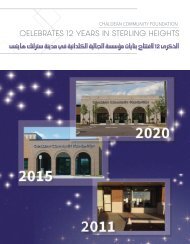Create successful ePaper yourself
Turn your PDF publications into a flip-book with our unique Google optimized e-Paper software.
FEATURE<br />
From Mesopotamia<br />
to the Motor City<br />
Early Chaldean settlers successfully navigated the change<br />
from agrarian villages to an industrial city lifestyle<br />
BY CAL ABBO<br />
Few members of the Chaldean<br />
community in Detroit still survive<br />
and remember what the village<br />
was like in the early 1900s, when<br />
our pioneers made the brave and challenging<br />
journey to America. What<br />
drove them to accomplish such a feat?<br />
To understand the enormity of<br />
such a journey, it’s necessary to recall<br />
the reality of village life and its simplicity.<br />
The vast majority of Chaldeans<br />
in the Middle East lived in small villages<br />
or towns with populations of a<br />
few thousand people. A small number<br />
of venturing families in the Nineveh<br />
Plain region moved to large, urban<br />
areas like Mosul, Basra, and Baghdad<br />
for economic opportunity, education,<br />
or a professional career.<br />
Chaldeans in the village tended to<br />
be farmers out of necessity and tradition.<br />
They grew crops like wheat,<br />
lentils, chickpeas, melons, fruits,<br />
and barley. Modern misconceptions<br />
characterize Iraq as a barren and dry<br />
desert, but the area where Chaldeans<br />
lived was green and fertile.<br />
As villagers who farmed for a living,<br />
there was not much wealth or opportunity<br />
to create it in the Chaldean community.<br />
In addition, villages were mostly<br />
unprotected, and had gone through<br />
hundreds of years of invasions, persecution,<br />
and repression. Despite these<br />
obstacles, the village provided the one<br />
thing that money couldn’t buy: closeness<br />
of family and community.<br />
In the late 1800s, word of economic<br />
opportunities in America began to<br />
reach the ears of young and enterprising<br />
Chaldean villagers. These pioneering<br />
men grew tired of the constant persecution<br />
they and their families had to<br />
deal with as well as a lack of opportunity<br />
to exceed. While Iraqi cities offered<br />
CHALDEAN<br />
STORY<br />
higher education and professional careers,<br />
it was nothing compared to the<br />
stories coming from recent immigrants<br />
to the United States. Chaldeans heard<br />
tales of great wealth and a different life<br />
from Lebanese and Syrian immigrants<br />
who made the journey before them.<br />
During the period between the turn<br />
of the century and 1920, drastic changes<br />
took the world by storm. Industrialization<br />
finally reached its tipping<br />
point and began to create vast wealth<br />
for the masses. In addition, war and<br />
genocide plagued the Middle East –<br />
namely the Seyfo, in which hundreds<br />
of thousands of Assyrian, Syriac, and<br />
Chaldean people were slaughtered,<br />
impacting the hearts and minds of many<br />
This report is made possible with generous support from<br />
Michigan Stories, a Michigan Humanities Grants initiative.<br />
Chaldean people in the Nineveh Plains.<br />
In the Seyfo, Telkaif often served<br />
as a safe haven for Christians who fled<br />
Kurdish and Ottoman violence. Villagers<br />
who were already there heard<br />
stories of ungodly torture and killings.<br />
Importantly, this was not the first time,<br />
nor the last, that a genocide like this<br />
would plague Middle Eastern Christians,<br />
and Chaldeans had the foresight<br />
to predict such occurrences. This further<br />
motivated them to move to new<br />
lands and start new lives. First, they<br />
had to overcome the pressures of family<br />
and community, which certainly<br />
weighed on their hearts when they<br />
first made the journey.<br />
In addition, the industrial age had<br />
finally reached America, and even the<br />
most menial labor was offered fairly<br />
high wages. Famously, Henry Ford<br />
advertised a $5-per-day wage to build<br />
cars in Detroit, which intrigued many<br />
Chaldeans. A few made their final<br />
preparations, said their goodbyes, and<br />
went on their way.<br />
The first Chaldean who immigrated<br />
42 CHALDEAN NEWS <strong>DECEMBER</strong> <strong>2023</strong>
















